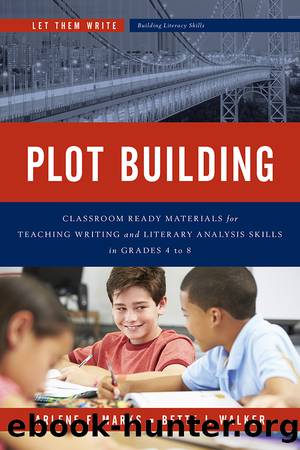Plot Building by Marks Arlene F.;Walker Bette J.; & Bette J. Walker

Author:Marks, Arlene F.;Walker, Bette J.; & Bette J. Walker [Marks, Arlene F. & Walker, Bette J.]
Language: eng
Format: epub
Publisher: Rowman & Littlefield Unlimited Model
Published: 2015-08-15T00:00:00+00:00
PBR 13
DRAMATIC CONFLICT SKILL 2:
BUILDING DRAMATIC CONFLICT
CONCRETE MATERIALS
A short picture book with a dramatic conflict (Day 2)
Chart headings on the board: Who?
What?
Why?
Whatâs in the way?
PBR 14âDRAMATIC CONFLICT B Worksheetâphotocopied double-sidedâclass set
TWO-WEEK MODULE
PURPOSE: Young authors practice building conflict as a first step in developing a story. In the process, they may come to understand the fundamental role played by dramatic conflict in real-life narratives as well.
DAY 1
STEP 1: The teacher reviews the chart headings on the front boardâWho, What, Why, and Whatâs in the way?âand discusses with the class the meaning for each. The teacher now adds above each heading its correct literary term: Protagonist, Goal, Motivation, and Antagonist(s).
STEP 2: The teacher now gives the class a story scenario. For example: The protagonist in this story is the coach of the school volleyball team. Sheâs been a champion player herself, has won many medals, has coached for ten yearsâbut her team has never won a tournament.
The teacher and class together now identify this protagonistâs goal and motivation, and discuss what might prevent her from achieving her goal (her antagonists). The teacher records each item under its appropriate column heading on the chart on the board.
STEP 3: The teacher now hands out a copy of the DRAMATIC CONFLICT B worksheet to each student. Students form working groups of three or four and proceed to discuss in their groups a dramatic conflict for the first line of the chart (the protagonist is a person your own age). Each group member records the components of this dramatic conflict on his or her own chart. Working together, group members then discuss several strategies the protagonist might try in order to overcome the major obstacle to his or her success (the main antagonist). Allow five to seven minutes.
STEP 4: The groups dissolve. Working independently, each student gives the protagonist a name, decides on a setting, and then first-drafts a paragraph describing how the protagonist was able to overcome the antagonist and achieve the goal. Allow ten minutes. If time permits, each author reads over his or her paragraph to fill in any missing words and correct any punctuation errors. Students are instructed to stand up when they are finished.
Students need to understand the importance of first-drafting quickly, to get ideas down on paper before they can be forgotten. There will be errors and omissions, but these can be corrected later on.
STEP 5: Standing students pair up (with a different partner each day) and take turns reading their paragraphs aloud to each other. The listening partner can offer suggestions for wording or actions that will make the story more interesting. Allow ten minutes.
STEP 6: That night for homework, each student redrafts the paragraph written in class, so that this time the protagonist is unable to achieve the goal. (That is, the character may be successful in overcoming a particular obstacle, but will still need to overcome at least one more antagonist in order to achieve the goal.) When done, the student reads
Download
This site does not store any files on its server. We only index and link to content provided by other sites. Please contact the content providers to delete copyright contents if any and email us, we'll remove relevant links or contents immediately.
The Art of Coaching Workbook by Elena Aguilar(50168)
Trainspotting by Irvine Welsh(21078)
Twilight of the Idols With the Antichrist and Ecce Homo by Friedrich Nietzsche(18324)
Fangirl by Rainbow Rowell(8819)
Periodization Training for Sports by Tudor Bompa(7946)
Change Your Questions, Change Your Life by Marilee Adams(7405)
This Is How You Lose Her by Junot Diaz(6476)
Asking the Right Questions: A Guide to Critical Thinking by M. Neil Browne & Stuart M. Keeley(5387)
Grit by Angela Duckworth(5322)
Red Sparrow by Jason Matthews(5226)
Paper Towns by Green John(4826)
Room 212 by Kate Stewart(4767)
Ken Follett - World without end by Ken Follett(4467)
The Sports Rules Book by Human Kinetics(4098)
Housekeeping by Marilynne Robinson(4084)
Double Down (Diary of a Wimpy Kid Book 11) by Jeff Kinney(3959)
Papillon (English) by Henri Charrière(3942)
The Motorcycle Diaries by Ernesto Che Guevara(3804)
Exercise Technique Manual for Resistance Training by National Strength & Conditioning Association(3798)
